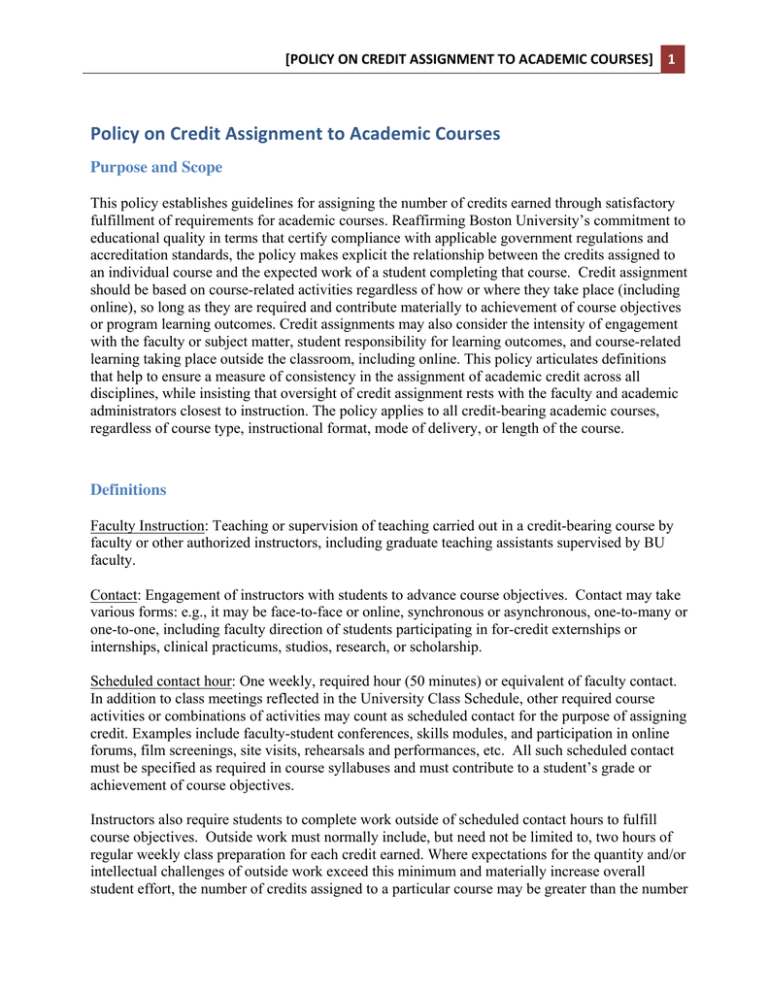Policy on Credit Assignment to Academic Courses
advertisement

[POLICY ON CREDIT ASSIGNMENT TO ACADEMIC COURSES] 1 Policy on Credit Assignment to Academic Courses Purpose and Scope This policy establishes guidelines for assigning the number of credits earned through satisfactory fulfillment of requirements for academic courses. Reaffirming Boston University’s commitment to educational quality in terms that certify compliance with applicable government regulations and accreditation standards, the policy makes explicit the relationship between the credits assigned to an individual course and the expected work of a student completing that course. Credit assignment should be based on course-related activities regardless of how or where they take place (including online), so long as they are required and contribute materially to achievement of course objectives or program learning outcomes. Credit assignments may also consider the intensity of engagement with the faculty or subject matter, student responsibility for learning outcomes, and course-related learning taking place outside the classroom, including online. This policy articulates definitions that help to ensure a measure of consistency in the assignment of academic credit across all disciplines, while insisting that oversight of credit assignment rests with the faculty and academic administrators closest to instruction. The policy applies to all credit-bearing academic courses, regardless of course type, instructional format, mode of delivery, or length of the course. Definitions Faculty Instruction: Teaching or supervision of teaching carried out in a credit-bearing course by faculty or other authorized instructors, including graduate teaching assistants supervised by BU faculty. Contact: Engagement of instructors with students to advance course objectives. Contact may take various forms: e.g., it may be face-to-face or online, synchronous or asynchronous, one-to-many or one-to-one, including faculty direction of students participating in for-credit externships or internships, clinical practicums, studios, research, or scholarship. Scheduled contact hour: One weekly, required hour (50 minutes) or equivalent of faculty contact. In addition to class meetings reflected in the University Class Schedule, other required course activities or combinations of activities may count as scheduled contact for the purpose of assigning credit. Examples include faculty-student conferences, skills modules, and participation in online forums, film screenings, site visits, rehearsals and performances, etc. All such scheduled contact must be specified as required in course syllabuses and must contribute to a student’s grade or achievement of course objectives. Instructors also require students to complete work outside of scheduled contact hours to fulfill course objectives. Outside work must normally include, but need not be limited to, two hours of regular weekly class preparation for each credit earned. Where expectations for the quantity and/or intellectual challenges of outside work exceed this minimum and materially increase overall student effort, the number of credits assigned to a particular course may be greater than the number [POLICY ON CREDIT ASSIGNMENT TO ACADEMIC COURSES] 2 of its scheduled contact hours. Examples include courses that entail extensive and/or intensive reading, writing, research, open-ended problem solving, practice-based assignments, or student responsibility for class meetings. Course types: The following course types are covered by this policy and are aligned in the chart below with credit assignment guidelines. • Classroom-based: Scheduled contact occurs primarily face-to-face in a classroom setting. • Faculty-directed independent learning: Scheduled contact occurs via faculty supervision of students pursuing directed study for credit for such activities as capstone projects, independent work for distinction, or graduate thesis and dissertation requirements. • Place-or practice-based: Scheduled contact occurs in non-classroom locations such as corporations (internships), schools, or clinics. • Blended: Scheduled contact is a defined mixture of face-to-face and distance/online interactions. • Online: Scheduled contact is mediated entirely online. Credit Assignment Guidelines For courses offered during a typical 15-week semester, the combination of scheduled contact and independent student effort must be equivalent to at least 3 hours per week per credit hour. The guidelines should be adjusted accordingly a) for shorter courses, b) as directed by external agencies such as specialized accreditors, or c) as warranted by the standards of the discipline. Type of Course Guideline Classroom-based courses, such as lectures, seminars, discussion sections, and studios Classroom-based courses. Typically, 1 credit per 1 scheduled contact hour, as defined above, per week. Each credit assigned includes an expectation of at least 2 hours of independent student effort for successful completion of the course. This guideline may be applied as written, or, for some seminars and other courses of this general type, it may be appropriate to apply a guideline of 1 credit per 3 hours of student effort per week, where “student effort” takes into account work both in and out of the classroom. Laboratories and studio courses. Typically, 1 credit per 2 scheduled contact hours per [POLICY ON CREDIT ASSIGNMENT TO ACADEMIC COURSES] 3 Faculty-directed independent learning Place- and Practice-based Blended Online week. Each credit assigned includes an expectation of at least 2 hours of independent student effort for successful completion of the course. For laboratories and studios that are paired with a classroom-based course, the total credits earned typically will not exceed 6 credits. 1 credit per 3 hours of student effort per week. 1 credit per 3 to 5 hours of student effort per week per credit for practicums, internships, externships, and clinical placements. See Table 1 See Table 1 Responsible Parties School and College faculties are responsible for assigning academic credit to individual courses, for ensuring that credit assignments meet policy guidelines, and for approving exceptions to the guidelines. Typically, this oversight will occur in the context of usual school and college processes for curriculum development and review, and within curriculum oversight bodies such as curriculum committees. The Vice President for Enrollment & Student Affairs and the Academic Deans are responsible for ensuring implementation of the policy by all credit-granting units of the University. The University Registrar oversees the course catalog and is responsible for reporting regularly on the status of courses vis-à-vis the Course Credit Assignment Policy to the University Provost, the Vice President for Enrollment & Student Affairs, and the Council of Deans. Effective Date: Effective June 1, 2015 for all new courses developed after that date. Full implementation for existing courses will be completed for the June 1, 2017 Bulletin. [POLICY ON CREDIT ASSIGNMENT TO ACADEMIC COURSES] 4 Table 1: Suggested Credit Assignment Guidelines by Learning and Teaching Activity in Online and Blended Courses. Activity Description / Technologies Credit Assignment Guideline Credit : Hours of Activity Per Week Online Lecture (asynchronous, Online lecture materials of 1:3 with interactive work) static text and graphics, enhanced with • Recorded (audio & video) segments or/and lecture capture • Interactive questions/quizzes with feedback • Animation, simulation Live Online Classroom with Video webinar with 1:1 Instructor application sharing • Lectures • Consulting with small student groups/teams Live Online Classroom with Video webinar with 1:1 Facilitator application sharing Online Discussion Boards Discussion Forums e.g., 1:3 (asynchronous): Blackboard or Google Hang-­‐ • Continuous for questions on out lecture, homework, projects, or exams • Topical graded discussions Online Lab Activities /Problem Recorded videos with 1:3 Solving Sessions: (asynchronous whiteboards or slides with student interaction) presentations • Videos with problem sets and solutions (in math & theory classes) • Virtual laboratories • Video tutorials & work with application • Simulations Live Project Presentation Sessions, Video webinar with 1:1 Conferences, Roundtables application sharing [POLICY ON CREDIT ASSIGNMENT TO ACADEMIC COURSES] 5 Background Principles: In addition to the principles explicitly stated in the proposed policy’s “Purpose and Scope,” the following principles were used to establish credit assignment guidelines. • For the foreseeable future, the credit hour will remain the standard for awarding BU credentials, reporting to external entities, and complying with federal and state regulations. Thus, the definition of a credit hour and the assignment of credit to courses must be consistent with external regulations and standards for accreditation. In addition, credit assignment policies and practices should meet or exceed the best practices at peer institutions. • Although the credit hour is a useful concept, its basis in face-to-face, lecturebased instruction in a classroom neither reflects the range of current practices nor acknowledges changing instructional practices, which extend beyond traditional lectures to include online and blended online or place-based courses; internships, clinical practicums, and field placements; “flipped” classrooms; and studios, laboratories, and rehearsals. Thus, credit assignment guidelines must balance the need to stipulate guidance with the need for flexibility in its application to a wide range of pedagogies. • Finally, the guidelines are intended to reflect the variety of pedagogies, learning outcomes, and expectations for academic effort and achievement present at BU; and, to anticipate, to the extent possible, emerging pedagogies and technologies, as well as regulatory changes. In all cases, assignment of credit to courses rests with the faculty and relevant academic governance bodies, as does oversight of compliance with policy guidelines. History: This proposal was drafted by the Course Credit Definition Committee: John Straub, Professor of Chemistry, CAS, and Laurie Pohl, Vice President for Enrollment & Student Affairs (co-­‐chairs) Lynne Allen, Professor and Director of the School of Visual Arts, CFA Jack Beermann, Professor, LAW Tobe Berkovitz, Associate Professor, COM John Caradonna, Associate Professor of Chemistry, CAS Janelle Heineke, Professor, Questrom Karen Jacobs, Clinical Professor, SAR J. Greg McDaniel, Associate Professor, ENG Anita Patterson, Professor of English, CAS L. Jay Samons, Professor of Classical Studies, CAS* Stan Sclaroff, Professor of Computer Science, CAS Adam Sweeting, Associate Professor, CGS Jeffrey von Munkwitz-­‐Smith, University Registrar, ex officio [POLICY ON CREDIT ASSIGNMENT TO ACADEMIC COURSES] 6 Tanya Zlateva, Associate Professor and Dean ad interim, MET *Professor Samons resigned from the committee in summer 2014. The policy was approved by the University Council Committee on Undergraduate Programs and Policies (UAPP) on xxxxx; by the University Council Committee on Graduate Programs and Policies on xxxxx (GAPP); and by the University Council on Yyyyyyy.
